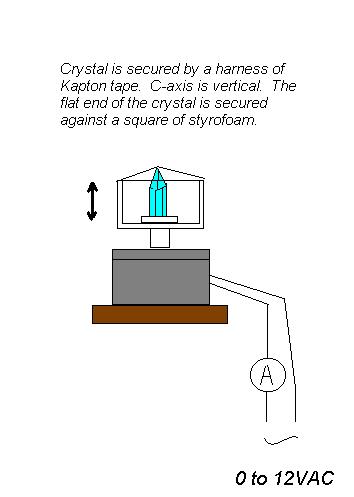| THE BRIDGES OF AVALON |
| MISSION STATEMENT |
| THE FOUNDERS |
| PUBLISHED MATERIAL |
| PERSONAL WRITING |
| FIELD STUDIES |
| RESEARCH |
| RELATED SITES |
| RESEARCH LAB - SERVICES |
| CONTACT TAF |
| HOME PAGE |
Experiment 150602A N.A. Reiter The experiment described here discloses the latest results in our on-going exploration of potential gravity or inertia anomalies exhibited by materials having a chiral or helical molecular structure. Recently, after further literature review, we found that common rock crystal quartz, alpha quartz, is a structure embodying an incredibly high value of chirality, due to the 120 degree staggering of SiO4 tetrahedra in chains parallel to the c-axis of the crystal. Values for sodium wavelength optical rotation are cited at around 11 to 15° per mm length. This appears to be perhaps two orders of magnitude higher than some organic chiral compounds, such as sucrose or corn syrup. Literature dealing with quartz crystals tells us that both right and left handed species are found in nature or in synthesis. Methods are described for determining chirality by examination of facets. A handy reference is found online here. Since March, we had seen milligram to sub-milligram weight alterations of sucrose and other chiral crystals from before and after mechanical vibration or agitation. Would a quartz crystal vibrated on its c-axis (long dimension, typically) show an anomalous apparent weight alteration after mechanical excitation? We selected a single point natural quartz crystal, weighing 37.750 grams. While not a textbook perfect sample, we determined the crystal to be left-handed. Using both manual shaking in different directions, and our 60 Hz vibrator (0 to 3mm amplitude), we tried a number of weighing runs, in similar protocol to earlier testing. Results were modest, on one occasion we observed a 3 mg weight increase. However, they were not as robust or dramatic as expected. On the other hand, we have speculated that perhaps the transient weight alteration seen now with a variety of materials and samples is but a minor after-effect of a much greater dynamic inertial alteration. The quartz crystal at hand gave us the incentive to test this thought in a novel way! Our 60Hz vibrator is essentially an old horn driver with a cup shaped test platform bolted to the armature. It rests on a rubber pad for vibration isolation. At about 12VAC, where we measure 3mm of amplitude, the unit typically draws around 2 amperes. In a firmly mounted configuration, we have confirmed that increasing or decreasing the mass / weight of a vibrated load will increase or decrease the total current drawn by the driver coil. A larger or heavier mass being vibrated will cause an increase in driver current. Thus, we are left with a novel means of gauging the presence of anomalous drag forces or inertial influence! We look for unusual changes in the current drawn by the driver! A test, or "dummy" mass was made to the approximate size and weight of the quartz crystal. It consisted of nylon and Teflon blocks connected together, to form a unit that weighs 39.522 grams, slightly more than the crystal. We then alternated vibrating the quartz crystal, point up on the c-axis, and the dummy load at different amplitudes and compared AC current draw by the driver coil. For each trial, we strapped the test piece, either crystal or dummy load, into the vibrator cup with a harness of Kapton tape. Both quartz and dummy load were tested sequentially at different amplitudes, designated by the power-stat dial settings: (Readings were taken at T+20 seconds after switch was turned on, units are amperes) Dummy Load Quartz .379A .382A .803A .815A 1.221A 1.239A 1.920A 1.947A Further tests and trials will be run. However, we do see an interesting pattern emerge that may suggest some sort of inertial anomaly is present during the vibrating of the quartz. We see a consistently higher current draw during the vibrating of the crystal, as though an added load or force was present! We find this surprising and intriguing. If anything, the dummy load is slightly heavier than the quartz, and is also more blunt on the end (force of air resistance) - thus intuitively being inclined to weight the results toward causing a slightly greater current draw than the crystal, in the absence of any unusual effects. If we are to presume the results to be genuine, which at this point we truly cannot, we would speculate that the chiral quartz crystal may be experiencing an anomalous inertial alteration in a dynamic condition. Further tests with other dummy loads, better vibration isolation, and more crystals are in order. We must also continue to evaluate these results and consider the many potential artifacts that are bound to be inherent.
|
